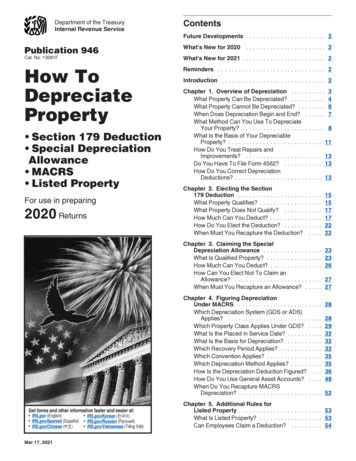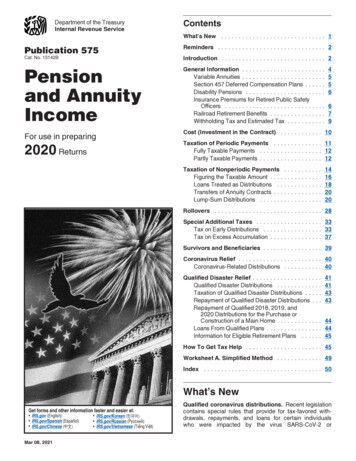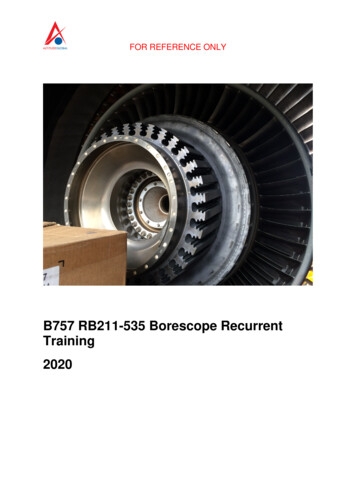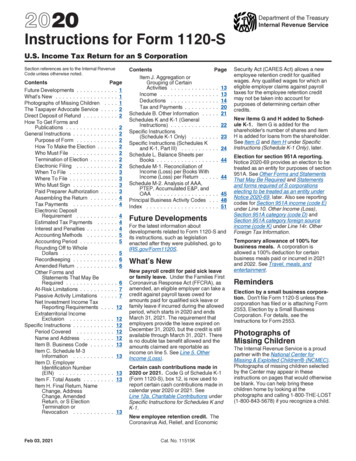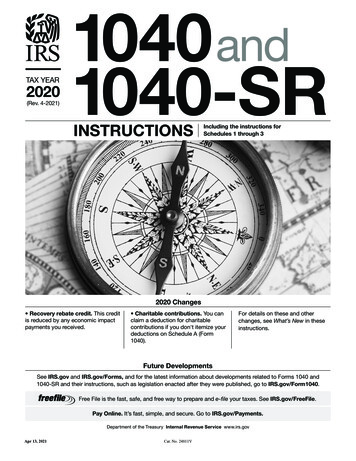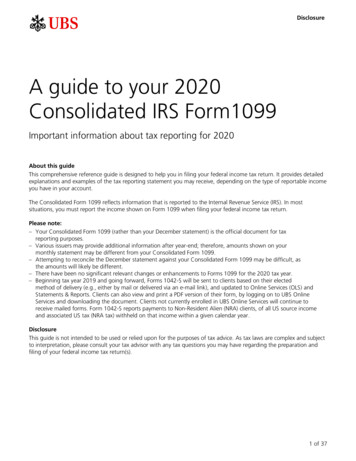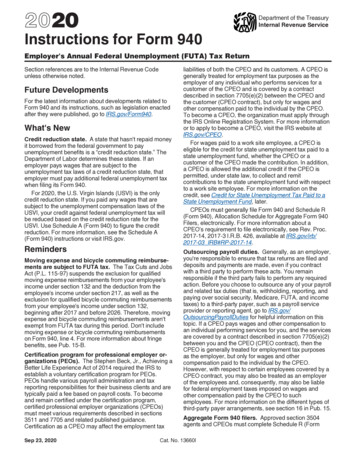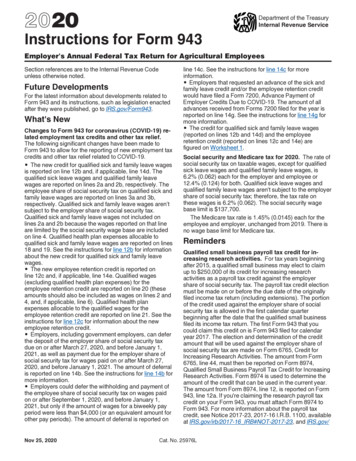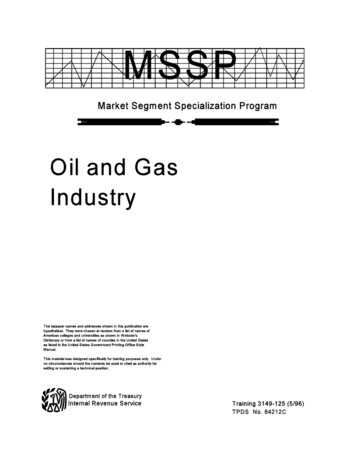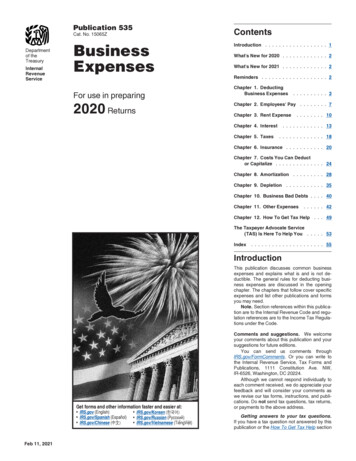
Transcription
Publication 535ContentsBusinessExpensesIntroduction . . . . . . . . . . . . . . . . . . 1Cat. No. 15065ZDepartmentof theTreasuryInternalRevenueServiceFor use in preparing2020 ReturnsWhat's New for 2020 . . . . . . . . . . . . . 2What's New for 2021 . . . . . . . . . . . . . 2Reminders . . . . . . . . . . . . . . . . . . . 2Chapter 1. DeductingBusiness Expenses. 3Chapter 2. Employees' Pay . . . . . . . . 7Chapter 3. Rent Expense. . . . . . . . . . . . 13Chapter 4. InterestChapter 5. Taxes. . . . . . . . 10. . . . . . . . . . . . . 18Chapter 6. Insurance . . . . . . . . . . . 20Chapter 7. Costs You Can Deductor Capitalize . . . . . . . . . . . . . . 24Chapter 8. Amortization . . . . . . . . . 28Chapter 9. Depletion . . . . . . . . . . . 35Chapter 10. Business Bad Debts . . . . 40Chapter 11. Other Expenses. . . . . . 42Chapter 12. How To Get Tax Help . . . 49The Taxpayer Advocate Service(TAS) Is Here To Help You . . . . . 53Index. . . . . . . . . . . . . . . . . . . . . 55IntroductionThis publication discusses common businessexpenses and explains what is and is not deductible. The general rules for deducting business expenses are discussed in the openingchapter. The chapters that follow cover specificexpenses and list other publications and formsyou may need.Note. Section references within this publication are to the Internal Revenue Code and regulation references are to the Income Tax Regulations under the Code.Get forms and other information faster and easier at: IRS.gov (English) IRS.gov/Spanish (Español) IRS.gov/Chinese (中文)Feb 11, 2021 IRS.gov/Korean (한국어) IRS.gov/Russian (Pусский) IRS.gov/Vietnamese (TiếngViệt)Comments and suggestions. We welcomeyour comments about this publication and yoursuggestions for future editions.You can send us comments throughIRS.gov/FormComments. Or you can write tothe Internal Revenue Service, Tax Forms andPublications, 1111 Constitution Ave. NW,IR-6526, Washington, DC 20224.Although we cannot respond individually toeach comment received, we do appreciate yourfeedback and will consider your comments aswe revise our tax forms, instructions, and publications. Do not send tax questions, tax returns,or payments to the above address.Getting answers to your tax questions.If you have a tax question not answered by thispublication or the How To Get Tax Help section
at the end of this publication, go to the IRS Interactive Tax Assistant page at IRS.gov/Help/ITA where you can find topics using thesearch feature or by viewing the categories listed.Getting tax forms, instructions, and publications. Visit IRS.gov/Forms to downloadcurrent and prior-year forms, instructions, andpublications.Ordering tax forms, instructions, andpublications. Go to IRS.gov/OrderForms toorder current forms, instructions, and publications; call 800-829-3676 to order prior-yearforms and instructions. The IRS will processyour order for forms and publications as soonas possible. Do not resubmit requests you've already sent us. You can get forms and publications faster online.Future DevelopmentsFor the latest information about developmentsrelated to Pub. 535, such as legislation enactedafter it was published, go to IRS.gov/Pub535.What's New for 2020The following items highlight some changes inthe tax law for 2020.Coronavirus (COVID-19) related employment tax credits. The Families First Coronavirus ResponseAct (FFCRA), enacted on March 18, 2020,provides certain employers with tax creditsthat reimburse them for the cost of providing paid sick and family leave wages totheir employees for leave related toCOVID-19. The Coronavirus Aid, Relief, and Economic Security Act (CARES Act), enactedon March 27, 2020, provides eligible employers with an employee retention taxcredit if they keep employees on their payroll, despite experiencing economic hardship related to COVID-19.For more information, see chapter 2.Film, television, and live theatrical production costs. The election to expense certaincosts of qualified film, television, and live theatrical productions has been extended to includecosts of productions that begin before January1, 2026. For more information, see chapter 7.Standard mileage rate. For tax year 2020, thestandard mileage rate for the cost of operatingyour car, van, pickup, or panel truck for eachmile of business use is 57.5 cents per mile. Formore information, see chapter 11.What's New for 2021The following item highlights a change in the taxlaw for 2021.Standard mileage rate. For tax year 2021, thestandard mileage rate for the cost of operatingyour car, van, pickup, or panel truck for eachmile of business use is 56 cents per mile.Page 2RemindersThe following reminders and other items mayhelp you file your tax return.IRS e-file (Electronic Filing)You can file your tax returns electronicallyusing an IRS e-file option. The benefits of IRSe-file include faster refunds, increasedaccuracy, and acknowledgment of IRS receiptof your return. You can use one of the followingIRS e-file options. Use an authorized IRS e-file provider. Use a personal computer. Visit a Volunteer Income Tax Assistance(VITA) or Tax Counseling for the Elderly(TCE) site.For details on these fast filing methods, seeyour income tax package.Form 1099-MISC. File Form 1099-MISC, Miscellaneous Income, for each person to whomyou have paid during the year in the course ofyour trade or business at least 600 in rents,prizes and awards, other income payments,medical and health care payments, and crop insurance proceeds. See the Instructions forForms 1099-MISC and 1099-NEC for more information and additional reporting requirements.Form 1099-NEC. File Form 1099-NEC, Nonemployee Compensation, for each person towhom you have paid during the year in thecourse of your trade or business at least 600 inservices (including parts and materials), who isnot your employee. See the Instructions forForms 1099-MISC and 1099-NEC for more information and additional reporting requirements.Gig Economy Tax Center. The IRS Gig Economy Tax Center on IRS.gov can help people inthis growing area meet their tax obligationsthrough more streamlined information.The gig economy is also known as the sharing, on-demand, or access economy. It usuallyincludes businesses that operate an app orwebsite to connect people to provide servicesto customers. While there are many types of gigeconomy businesses, ride-sharing and homerentals are two of the most popular.The Gig Economy Tax Center streamlinesvarious resources, making it easier for taxpayers to find information about the tax implicationsfor the companies that provide the services andthe individuals who perform them. It offers tipsand resources on a variety of topics including: Filing requirements; Making quarterly estimated income taxpayments; Paying self-employment taxes; Paying FICA, Medicare, and AdditionalMedicare taxes; Deductible business expenses; and Special rules for reporting vacation homerentals.For more information, go to the GigEconomy Tax Center at IRS.gov/Gig.Photographs of missing children. The Internal Revenue Service is a proud partner with theNational Center for Missing & ExploitedChildren (NCMEC). Photographs of missingchildren selected by the Center may appear inthis publication on pages that would otherwisebe blank. You can help bring these childrenhome by looking at the photographs and calling1-800-THE-LOST (1-800-843-5678) (24 hoursa day, 7 days a week) if you recognize a child.Preventing slavery and human trafficking.Human trafficking is a form of modern-day slavery, and involves the use of force, fraud, or coercion to exploit human beings for some type oflabor or commercial sex purpose. The UnitedStates is a source, transit, and destinationcountry for men, women, and children, bothU.S. citizens and foreign nationals, who aresubjected to the injustices of slavery and human trafficking, including forced labor, debtbondage, involuntary servitude, “mail-order”marriages, and sex trafficking. Trafficking inpersons can occur in both lawful and illicit industries or markets, including in hotel services,hospitality, agriculture, manufacturing, janitorialservices, construction, health and elder care,domestic service, brothels, massage parlors,and street prostitution, among others.The President’s Interagency Task Force toMonitor and Combat Trafficking in Persons(PITF) brings together federal departments andagencies to ensure a whole-of-government approach that addresses all aspects of humantrafficking. Online resources for recognizing andreporting trafficking activities, and assisting victims include the Department of Homeland Security (DHS) Blue Campaign at DHS.gov/bluecampaign, the Department of State Office toMonitor and Combat Trafficking in Persons atState.gov/j/tip, and the National Human Trafficking Resource Center (NHTRC) athumantraffickinghotline.org. DHS is responsiblefor investigating human trafficking, arrestingtraffickers, and protecting victims. DHS alsoprovides immigration relief to non-U.S. citizenvictims of human trafficking. DHS uses a victimcentered approach to combating human trafficking, which places equal value on identifyingand stabilizing victims and on investigating andprosecuting traffickers. Victims are crucial to investigations and prosecutions; each case andevery conviction changes lives. DHS understands how difficult it can be for victims to comeforward and work with law enforcement due totheir trauma. DHS is committed to helping victims feel stable, safe, and secure.To report suspected human trafficking, callthe DHS domestic 24-hour toll-free number at866-DHS-2-ICE(866-347-2423)or802-872-6199 (non-toll-free international). Forhelp from the NHTRC, call the National HumanTrafficking Hotline toll free at 888-373-7888 ortext HELP or INFO to BeFree (233733).The U.S. Department of the Treasury’s Financial Crimes Enforcement Network (FinCEN)has issued a public advisory to financial institutions that contains red flag indicators for potential suspicious financial activity associated withhuman trafficking. If warranted, financial institutions should file a Suspicious Activity Report(FinCEN 112) with FinCEN to report thesePublication 535 (2020)
activities. For more information, -A008.pdf.to538 Accounting Periods and Methods538542 Corporations542547 Casualties, Disasters, and Thefts547583 Starting a Business and KeepingRecords583587 Business Use of Your Home5871.925 Passive Activity and At-Risk Rules925936 Home Mortgage derDeduction for qualified business income.For tax years beginning after 2017, you may beentitled to take a deduction of up to 20% of yourqualified business income from your qualifiedtrade or business, plus 20% of the aggregateamount of qualified real estate investment trust(REIT), and qualified publicly traded partnershipincome.Small business taxpayers. For tax years beginning after 2017, more small business taxpayers may qualify to use the cash method of accounting and be exempt from capitalizingcertain expenses under section 263A. In addition, small business taxpayers may not be required to account for inventories under section471 and are not subject to the business interestexpenses limitation.IntroductionThis chapter covers the general rules for deducting business expenses. Business expenses are the costs of carrying on a trade or business, and they are usually deductible if thebusiness is operated to make a profit.TopicsThis chapter discusses: What you can deductHow much you can deductWhen you can deductNot-for-profit activitiesUseful ItemsYou may want to see:946 How To Depreciate Property946Form (and Instructions)Schedule A (Form 1040) ItemizedDeductionsSchedule A (Form 1040)5213 Election To PostponeDetermination as To Whether thePresumption Applies That anActivity Is Engaged in for Profit5213See chapter 12 for information about gettingpublications and forms.What Can I Deduct?To be deductible, a business expense must beboth ordinary and necessary. An ordinary expense is one that is common and accepted inyour industry. A necessary expense is one thatis helpful and appropriate for your trade or business. An expense does not have to be indispensable to be considered necessary.Even though an expense may be ordinaryand necessary, you may not be allowed to deduct the expense in the year you paid or incurred it. In some cases, you may not be allowedto deduct the expense at all. Therefore, it is important to distinguish usual business expensesfrom expenses that include the following. The expenses used to figure cost of goodssold. Capital expenses. Personal expenses.Cost of Goods SoldIf your business manufactures products or purchases them for resale, you must generallyvalue inventory at the beginning and end ofeach tax year to determine your cost of goodssold. Some of your business expenses may beincluded in figuring cost of goods sold. Cost ofgoods sold is deducted from your gross receipts to figure your gross profit for the year. Ifyou include an expense in the cost of goodssold, you cannot deduct it again as a businessexpense.529 Miscellaneous DeductionsThe following are types of expenses that gointo figuring cost of goods sold. The cost of products or raw materials, including freight. Storage. Direct labor (including contributions to pension or annuity plans) for workers who produce the products. Factory overhead.536 Net Operating Losses (NOLs) forIndividuals, Estates, and TrustsUnder the uniform capitalization rules, youmust capitalize the direct costs and part of thePublication334 Tax Guide for Small Business334463 Travel, Gift, and Car Expenses463525 Taxable and Nontaxable Income525529536Chapter 1indirect costs for certain production or resaleactivities. Indirect costs include rent, interest,taxes, storage, purchasing, processing, repackaging, handling, and administrative costs.This rule does not apply to small businesstaxpayers. You qualify as a small business taxpayer if you (a) have average annual gross receipts of 26 million or less for the 3 prior taxyears, and (b) are not a tax shelter (as definedin section 448(d)(3)). If your business has notbeen in existence for all of the 3-tax-year periodused in figuring average gross receipts, baseyour average on the period it has existed, and ifyour business has a predecessor entity, includethe gross receipts of the predecessor entityfrom the 3-tax-year period when figuring average gross receipts. If your business (or predecessor entity) had short tax years for any of the3-tax-year period, annualize your business’gross receipts for the short tax years that arepart of the 3-tax-year period. See Pub. 538 formore information.For more information, see the followingsources. Cost of goods sold—chapter 6 of Pub.334. Inventories—Pub. 538. Uniform capitalization rules—Pub. 538 andsection 263A and the related regulations.Capital ExpensesYou must capitalize, rather than deduct, somecosts. These costs are a part of your investmentin your business and are called “capital expenses.” Capital expenses are considered assetsin your business. In general, you capitalizethree types of costs. Business start-up costs (see Tip below). Business assets. Improvements.You can elect to deduct or amortizeTIP certain business start-up costs. Seechapters 7 and 8.Cost recovery. Although you generally cannottake a current deduction for a capital expense,you may be able to recover the amount youspend through depreciation, amortization, ordepletion. These recovery methods allow you todeduct part of your cost each year. In this way,you are able to recover your capital expense.See Amortization (chapter 8) and Depletion(chapter 9) in this publication. A taxpayer canelect to deduct a portion of the costs of certaindepreciable property as a section 179 deduction. A greater portion of these costs can be deducted if the property is qualified disaster assistance property. See Pub. 946 for details.Going Into BusinessThe costs of getting started in business, beforeyou actually begin business operations, arecapital expenses. These costs may include expenses for advertising, travel, or wages fortraining employees.If you go into business. When you go intobusiness, treat all costs you had to get yourbusiness started as capital expenses.Deducting Business ExpensesPage 3
Usually, you recover costs for a particularasset through depreciation. Generally, you cannot recover other costs until you sell the business or otherwise go out of business. However,you can choose to amortize certain costs forsetting up your business. See Starting a Business in chapter 8 for more information on business start-up costs.If your attempt to go into business is unsuccessful. If you are an individual and yourattempt to go into business is not successful,the expenses you had in trying to establishyourself in business fall into two categories.1. The costs you had before making a decision to acquire or begin a specific business. These costs are personal and nondeductible. They include any costsincurred during a general search for, orpreliminary investigation of, a business orinvestment possibility.2. The costs you had in your attempt to acquire or begin a specific business. Thesecosts are capital expenses and you candeduct them as a capital loss.If you are a corporation and your attempt togo into a new trade or business is not successful, you may be able to deduct all investigatorycosts as a loss.The costs of any assets acquired duringyour unsuccessful attempt to go into businessare a part of your basis in the assets. You cannot take a deduction for these costs. You will recover the costs of these assets when you dispose of them.Business AssetsThere are many different kinds of business assets, for example, land, buildings, machinery,furniture, trucks, patents, and franchise rights.You must fully capitalize the cost of these assets, including freight and installation charges.Certain property you produce for use in yourtrade or business must be capitalized under theuniform capitalization rules. See Regulationssection 1.263A-2 for information on these rules.De Minimis Safe Harbor forTangible PropertyAlthough you must generally capitalize costs toacquire or produce real or tangible personalproperty used in your trade or business, suchas buildings, equipment, or furniture, you canelect to use a de minimis safe harbor to deductthe costs of some tangible property. Under thede minimis safe harbor for tangible property,you can deduct de minimis amounts paid to acquire or produce certain tangible business property if these amounts are deducted by you for financial accounting purposes or in keeping yourbooks and records. See the following for the requirements for the de minimis safe harbor.You have an applicable financial statement.If you elect the de minimis safe harbor for thetax year, you can deduct amounts paid to ac-Page 4Chapter 1quire or produce certain tangible business property if: You have a trade or business or are a corporation, partnership, or S corporation thathas an applicable financial statement; You have, at the beginning of the tax year,written accounting procedures treating asan expense for nontax purposes:– Amounts paid for property costingless than a certain dollar amount, or– Amounts paid for property with aneconomic useful life of 12 months orless; You treat the amount paid during the taxyear for which you make the election as anexpense on your applicable financial statements in accordance with your written accounting procedures; The amount paid for the property does notexceed 5,000 per invoice (or per itemsubstantiated by invoice); and The uniform capitalization rules do not apply to the amount.You do not have an applicable financialstatement. If you elect the de minimis safeharbor for the tax year, you can deduct amountspaid to acquire or produce certain tangible business property if: You have a trade or business, partnership,or S corpora
at the end of this publication, go to the IRS In-teractive Tax Assistant page at IRS.gov/ Help/ITA where you can find topics u
